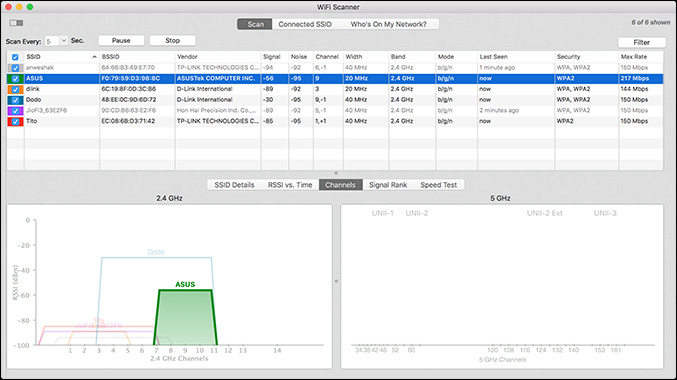

Probe request interval seen on smartphone OS vendors (iOS, Android, others) - varies greatly based on apps, device upgrades, and other factors 4.ĭata frames received from all connected WiFi devices and probe requests detected from all devices seen within range (typically up to 100 feet or more) generate "seen device" events on Meraki Access Points. Varies, could require user to manually search for networks Smartphones send probe requests to discover surrounding wireless networks, so that they can make the networks available to the user.

WiFi devices typically emit a probe request at regular intervals based on the device state (see Table 1).
#WIFI ANALYTICS TOOL FOR MAC SERIES#
These features are part of Cisco Meraki's MR series wireless access points.Ĭisco Meraki Access Points generate a presence signature from any WiFi-enabled device by detecting probe requests and 802.11 data frames, whether or not the device is associated to the network 3. This whitepaper explores Cisco Meraki's location functionality and offers insights into the technology behind these features and some of the use-cases that it can enable. Viewed holistically, Meraki's built-in location analytics views and real-time location API complement the existing traffic analytics functionality and complete a 360-degree understanding of devices on- and within range of a Cisco Meraki network. Not only can this facilitate a deeper integration with traditional customer relationship management (CRM) platforms, but, due to its real-time nature, it opens doors to next-generation customer engagement initiatives. Additionally, Meraki Scanning API is capable of exporting raw data from the observed probe requests, which organizations can use to integrate directly with third-party data warehousing or analytics platforms. Meraki is able to provide these analytics to all organizations by leveraging the industry-leading cloud architecture that is behind all Cisco Meraki products. visitors), user engagement (total time spent), and visitor loyalty (new vs. This is done through intuitive and customizable graphs that can be used to understand trends such as capture rate (passersby vs. Meraki wireless Access Points and cloud infrastructure gathers this data and presents it in aggregate on the Meraki Dashboard. Since smartphones now have greater than 50% penetration across the general population 2, probe requests can be used to build and detect a statistically significant data set regarding the presence of WiFi enabled devices within range of a given access point. These devices can be detected by WiFi access points irrespective of its WiFi association state meaning that even if a user does not connect his or her device to the wireless network, the device's presence can still be detected while the device is within range of the network and the device's WiFi antenna is turned on 1. The frames contain information that can be used to identify presence, time spent, and repeat visits within range of a WiFi access point. These 802.11 management frames are transmitted at regular intervals from WiFi devices. Smartphones with WiFi can now be used as an indicator of customer presence thanks to a WiFi mechanism that is common across all such devices: probe requests. For retail, this can help combat trends such as the erosion of in-store sales to online retailers, who for years have had access to similar data via the analytics produced by online tools (e.g., click-through conversion rates from online advertising). This location information, based predominantly on 802.11 wireless and bluetooth standards, can be used to engage users and optimize marketing strategies. With the rapid adoption of mobile devices, many organizations can now leverage data to better understand foot traffic patterns and behavior in a brick-and-mortar environment.


 0 kommentar(er)
0 kommentar(er)
